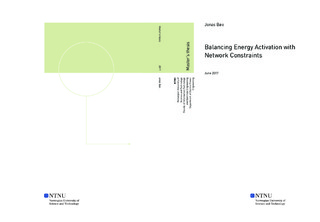| dc.description.abstract | ENTSO-E has established the framework for integration of European balancing markets in the EU regulation "Guideline on Energy Balancing" (GL-EB). Differences in balancing market design between European countries prevent the exchange of balancing energy and optimal use of resources. Integration of balancing markets is motivated by the EU targets on integration of renewable energy, enhance social welfare and reduce EU dependency on energy imports.
Key ingredients necessary to facilitate balancing market integration is a set of standardized balancing energy products, referred to as Standard Products, and an optimisation algorithm that decide optimal use of balancing resources. The algorithm is also referred to as Activation optimisation Function (AOF).
A proposal for AOF has been developed in this thesis. A real-time dispatch, DCOPF, balancing energy activation model that takes network flows into consideration and schedules FCR, aFRR and mFRR to balance Nordic imbalances in Nordic synchronous system is formulated in XPRESS. A network representation of the Nordic transmission system is input to the model together with a common, fictional Nordic bid list consisting of mFRR Standard Products. Nordic system frequency is modelled by a simplified system frequency bias factor and FCR activation. Imbalance forecast errors are represented with a fictional forecast deviation scaling factor. 5 scenarios are used to investigate model behavior upon change in Standard Product and network characteristics.
It is observed that the scenario in which no balancing energy can be exchanged between the Nordic countries leads to highest balancing cost and consequently lowest social welfare. This is because an increased activation of FCR and aFRR on the expenditure of reduced use of cheaper mFRR activations and low imbalance netting. The Reference scenario with exchange of balancing energy between Nordic countries showed a reduction in balancing cost by 22 \% and increase in netted imbalance volume by 18 \% compared to the Low Integration scenario. It is concluded that a large portion of mFRR activations are done to prevent violation of transmission capacities since the merit order is more closely followed when all transmission capacities are set to long term thermal values, in comparison to when transmission capacities are determined by Net Transfer Capacities (NTCs).
Producer ability to deliver balancing bids with short Full Activation Time (FAT) and minimum duration of delivery period allow the model to balance more of system imbalance with mFRR which reduce balancing cost and increase social welfare. A 9 \% reduction in balancing cost is observed when all mFRR bids have minimum duration of 5 minutes and 3 \% increase in balancing cost when number of bids with long Full Activation Time (FAT) is increased in the No P5 scenario.
An important simplification is the FCR modelling and indirect pricing of frequency deviations through a fictional FCR price. Sensitivity analysis of FCR price shows an increase in aFRR activations with increased FCR price. Possibility of consecutive mFRR delivery periods without new Full Activation Time (FAT) is an important cause of low balancing cost in scenario with short minimum duration of mFRR bids.
Results demonstrate that sufficient transmission capacity between balancing areas is a key element in increasing imbalance netting and reducing inefficient resource usage. Results also demonstrate the value of flexible mFRR products, i.e. bids with short Full Activation Time (FAT) and short minimum duration of delivery period. | |

